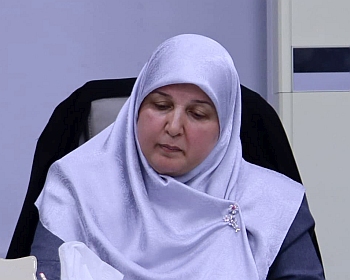 ناقش قسم علوم الحياة في كلية التربية للعلوم الصرفة (ابن الهيثم) رسالة الماجستير الموسومة ( دارسة تردد بعض جينات بروتينات الأسبارتيل المفرزة من النوع ألأكثر تردداً من المبيضات المعزولة من مرضى السكري ) للطالبة ( نورس نجم عبد الله ) التي انجزتها باشراف التدريسي في القسم ( أ.م.د. ثامر عبد الشهيد محسن ) و التدريسي في جامعة النهرين ( أ.د. محسن هاشم رسن ) ونوقشت من قبل أعضاء لجنة المناقشة المبينة أسمائهم في ما يأتي :
ناقش قسم علوم الحياة في كلية التربية للعلوم الصرفة (ابن الهيثم) رسالة الماجستير الموسومة ( دارسة تردد بعض جينات بروتينات الأسبارتيل المفرزة من النوع ألأكثر تردداً من المبيضات المعزولة من مرضى السكري ) للطالبة ( نورس نجم عبد الله ) التي انجزتها باشراف التدريسي في القسم ( أ.م.د. ثامر عبد الشهيد محسن ) و التدريسي في جامعة النهرين ( أ.د. محسن هاشم رسن ) ونوقشت من قبل أعضاء لجنة المناقشة المبينة أسمائهم في ما يأتي :
-
أ.د. أسماعيل عباس جديع (رئيسا)
-
أ.م.د. محمد مهدي جواد (عضوا)
-
م.د. اطياف سعيد (عضوا)
-
أ.م.د. ثامر عبد الشهيد محسن (عضوا ومشرفا)
-
أ.د. محسن هاشم رسن (عضوا ومشرفا)
نظرا لقله الراسات في العراق حول تردد جينات SAP في انواع مختلفه من المبيضات استهدفت الرسالة الى دراسة تردد بعض جينات بروتينات الاسبارتيل المفرزة من النوع الاكثر ترددا من المبيضات المعزولة من مرضى السكري.
تم جمع 240 عينة مقسمة الى مجموعتين الاولى 120 عينه لمرضى السكري و والثانية 120 عينة للاشخاص الذين لا يعانون من امراض مزمنة ( من المركز الوطني لعلاج وبحوث السكري ومستشفى العلويه للولاده وبعض المراكز الصحيه ) وكل مجموعة تضمنت 90 عينة من الفم و20 عينة من الادرار و10 عينات من المهبل ,اظهرت نتائج العزل المظهري وجود 28 ، 5 ، 2 عزلة موجبة من المبيضات المعزوله من الفم والادرار والمهبل على التوالي لمرضى السكري مقارنةً بعدد العزلات موجبة للاشخاص الاصحاء والتي كانت 10، 2 ، 6 عزلة من الفم والادرار والمهبل على التوالي.. كما بينت النتائج إن عدد العزلات الموجبة في النساء لمرضى السكري والاصحاء كانت اكثر من الرجال اذ كان عدد الاصابات في النساء بداء المبيضات لمرضى السكري والاصحاء 25 ، 10على التوالي ، في حين إن عدد الرجال المصابين بالمبيضات لمرضى السكري والاصحاء كان 16، 2 على التوالي. سجلت 28 عزلة موجبة أخذت من الفم لمرضى السكري وسجلت الفئة العمرية 51-70 سنة أكثر إصابة بالمبيضات وبنسبة 57.14% بينما كانت الفئة العمرية 20 -30 سنه اقل نسبة ظهور للمبيضات وصلت الى 14.29% ، اما الاصحاء فقد ظهرت 10 عزلات موجبة معزولة من الفم كانت اعلاها الفئة العمرية 20-30 التي ظهرت فيها المبيضات وبنسبة 60% أما الفئتين العمريتين 31-40 و 51-70 سنه اقل نسبة ظهور للمبيضات إذ بلغت 10% لكل فئة سجلت 5 عزلات موجبة جمعت من ادرار مرضى السكري وعزلتين موجبة من الاصحاء وسجلت الفئة 51-70 سنه اعلى نسبة للمبيضات وبنسبة 80% و100% في مرضى السكري والاصحاء على التوالي. تم عزل 2 عزلة موجبة من مهبل النساء المصابات بداء السكري بواقع عزلة واحدة للفئتين العمريتين 20-30 سنة و31-40 سنة وبنسبة 50% لكل منهما ، في حين سجلت 6 عزلات من المهبل في الاصحاء وبواقع 4 عزلات للفئة 20-30 سنه وبنسبة 66.66% وعزلة واحدة لكل من الفئتين العمريتين 31-40 سنه و41-50 سنة وبنسبة 16.66% لكل فئة. ظهرت مستعمرات جنس المبيضات بشكل دائري او بيضوي محدب ذات لون ابيض كريمي لماعة ناعمة الملمس عند تنميتها على وسط (SDA) Sabourand Dextrase Agar ، وبينت نتائج الفحص المجهري للمستعمرات النامية على وسط SDA بعد صبغها باللاكتوفينول بشكل خلايا كروية او بيضوية ذات حدود خضراء مائله للازرق بسبب تجمع الصبغة على الجدار الموجب لصبغه كرام ولوحظ بعض الخلايا المتبرعمة . شخصت انواع المبيضات بإستعمال وسط chrom agar إذ ظهر نوع C.albicans بلون اخضر فاتح ونوع C.glabrata كان بلون وردي شاحب اما نوع C.tropecalis فكان بلون ازرق في حين ان نوع C.dublineiensis ظهر بلون اخضر داكن. أظهرت النتائج إن نوع C.albicans له القدرة على النمو في درجة حراره 45 ْم وكذلك تكوين الانبوب الجرثومي . أظهر النوع C,tropicalis قابليته على النمو السطحي على وسط (SDB) Dextrose Sabouraud Broth . بينت النتائج إن النوع C.albicans هو أكثر الأنواع إصابة لمرضى السكري في (الفم ،الادرار، المهبل ) وبنسبة 62.86% تلتها C.tropecalis بنسبة 17.14% ثم C.glabrata بنسبة 11.43% واخيراً C. dubineinsis بنسبة 8.57% ، كما اشار الجدول ان اكثر مناطق الجسم تعرضاً للاصابة بداء المبيضات هو الفم ثم الادرار واخيراً المهبل وبعدد 28، 5 و2 على التوالي. اما بالنسبة للأصحاء كان النوع الاكثر إصابة هو C. dublieniensis وبنسبة 55.56% تلتها C.albicans بنسبة 33.33% ثم تلتها C.tropecalis بنسبة 11.11% ، إظهرت النتائج إن الفم أكثر المناطق إصابة من المهبل والادرار إذ كانت 10 عزلات تلاه المهبل ثم الادرار وبعدد 6 ، 2 على التوالي. بينت النتائج إن جميع عزلات C.albicans لمرضى السكري قادرة على تكوين الأغشية الحيوية بينما كونت الأغشية الحيوية ثلاثة عزلات من اصل 6 للأصحاء. كان تركيز الحمض النووي الرايبوزي منقوص الاوكسجين Deoxyribonucleic acid (DNA) بعد قياسه في جهازSpecteophotometer Nanodrop على الطولين الموجيين 260 و 280 نانوميتر ذات تركيز مثالي لإكمال عملية تضاعف البلمره المتسلسل ((PCR, استعملت عينات DNA المستخلصة من انواع المبيضات للكشف عن انواع الجينات المدروسة وقد تضمنت 20 عزلة لاربعة أنواع من المبيضات 1-9 C.albicans، 10-16 C.galabrata ، 17-18 C. dublienensis ،19-20 (C.tropicals ، ان اعلى درجة تركيز DNA كانت في نوع C.glabrata في العزلات رقم 13 و14وصلت الى 250.79 و82.08 نانوغرام على التوالي تلاه نوع C.albicans إذ سجلت العزلتين 6 و7 تركيز 33.79 و 32.52 نانوغرام على التوالي بينما كانت تركيز DNA لنوع C.tropicalis قليلة في العزلتين 19 و20 اذ كانت 6.45 نانوغرام لكلتاهما ، سجلت العزلة 3 للنوع C.albicans أعلى نقاوة تلته العزلة 14 للنوع C.glabrata ثم العزلة 17 للنوع C.dubliniensis اذ كانت ( 1.86 ، 1.84 ، 1.82) نانوميتر على التوالي فيما سجلت اقل درجة نقاوة للعزلة 4 لنوع C.albicans إذ بلغت 1.58 نانومتر. كانت النتائج إيجابية لجميع العزلات المدروسة للكشف عن جينات بروتينات الاسبارتيل المفرزه SAP1 و SAP7 إذ كانت جميع العزلات تحتوي على SAP1 عند578 bp (زوج قاعده ) و SAP7 عند 644bp (زوج قاعده).
وخلصت الطالبة الى التوصيات الاتية:
-
التوسع في اجراء دراسات عن داء المبيضات لأمراض مزمنة اخرى .
-
التوسع في دراسة الانواع الاخرى لجينات SAP لانواع المبيضات المختلفةلقلة الدراسات عليها .
-
إستعمال الطرق الجزيئية الأكثر تقدماً (RT-PCR) اي معرفه التعبير الجيني في الوقت الحقيقي هل هو فعلا أثناء الإصابة .
-
المقارنة بين معدل ارتفاع التعبير الجيني ((RT-PCR بين نوعين من الامراض المزمنة.










